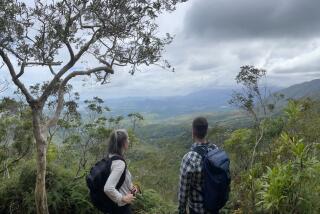‘Whole-Genome Shotgun’ Missed Its Mark
- Share via
WASHINGTON — It was the boast heard round the world of science: Surfer-turned-researcher J. Craig Venter announced that he would map human DNA quicker, cheaper and better than an international team that had already chewed on the problem for eight years.
Venter was so sure of his method, called “whole-genome shotgun,” that he impudently prodded the international team to shift its attention from man to a less glorious organism, the mouse.
It didn’t. And thus was born one of the fiercest rivalries in science: the race to map the human genome. More than ego and a potential Nobel Prize were at stake. Venter planned to charge a fee for his data, while the international team planned to release it for free. If Venter could build his toll road to the data as quickly as he said, then researchers would have to pay him, at least for a while, for crucial information about genes that might help cure diseases.
Today, some scientists say Venter’s plan came up short.
Scientists who have read the formal report of his effort, to be published Monday in the journal Science, say he basically abandoned his strategy as unworkable. Venter did produce a high-quality map of DNA, they say, but only after adopting a technique similar to the international team’s plan. He also relied heavily on his rivals’ data--the very data that he said they should not bother generating.
“He represented his idea as a revolutionary approach and that the public effort was too dumb to recognize that it works. . . . But the whole-genome approach failed,” said Philip Green, a specialist in computer-based DNA analysis at the University of Washington in Seattle, who is not a member of either team.
“All the king’s horses and all the king’s men could not put the genome together again,” said Eric Lander, a leader of the international team from the Whitehead Center for Genome Research in Cambridge, Mass. Instead of a complete map of DNA, Lander said, Venter wound up with “a tossed genome salad.”
Venter’s team said its project was a success but acknowledged that it did not assemble its map in the way Venter initially planned.
The debate over Venter’s method would be an arcane matter were it not for his company’s effort to control access to the genetic code. At one point in 1999, Venter’s technique seemed so successful that the international team, which was backed by government money, considered and then rejected a collaboration that would give Venter’s company exclusive rights to the code for up to a year.
Mapping the genome is like cutting a picture into millions of pieces, then trying to assemble them like a jigsaw puzzle.
The challenge is especially complicated because many segments of human DNA are identical to each other. Like a puzzle of a polar bear in a snowstorm, there are often no clues to where any individual piece belongs.
The international team decided that the best approach was to first divide human DNA into 30,000 smaller puzzles, then solve the small sections one at a time. It took extra work to create the smaller puzzles, but scientists could then be sure of the general area where each individual piece belonged.
Venter said all this was unnecessary. He said his company would assemble a set of computers so powerful that they could solve the genome as a giant, 43-million-piece puzzle--hence the name “whole-genome shotgun.”
Promoting the strategy helped Venter build an identity for Celera, which aimed to map and study the DNA of humans and other species and sell the data to subscribers. It also sparked several congressional hearings on the merits of each approach.
What happened when Venter tried to “shotgun” all human DNA?
Venter’s team was able to assemble the millions of small DNA pieces into nearly 119,000 clumps. But it never tried to figure out how those clumps fit together into a final assembly, according to the international team and independent scientists.
Venter’s paper is silent on why he failed to assemble the 119,000 pieces, but other scientists say it had to be because the task could not be done without significant difficulty.
“The 119,000 pieces--I call that a mess, and it would have taken a lot more data for them to move forward” and fit those pieces together, said Dr. Robert Waterston, a leader of the international team at Washington University in St. Louis.
“What they did was give up,” said Maynard Olson, a member of the international team at the University of Washington, who had predicted in 1998 that Venter would end up with about 100,000 pieces.
“We did not attempt to order the whole-genome scaffolds on the chromosomes,” said Mark Adams, a vice president at Venter’s Celera Genomics Corp., “because it’s a lot of work, and we had made the commitment to this [approach], and that’s the one we were going to go forward and publish.”
Adams also said the company could have assembled the “scaffolds” to cover more than 90% of the DNA puzzle, had it chosen to.
Rather than assemble the 119,000 sections, Venter’s team built its map by associating its DNA puzzle pieces to known markers in the genome. In doing so, it relied heavily on locational clues that the international team had laid out by cutting the genome into 30,000 smaller puzzles.
In the end, Venter needed the very data “that he told us for years was wasteful, stupid and unnecessary,” Lander said.
Venter’s experiment is hardly a loss for him or for science. Celera now earns millions of dollars by selling its data about the DNA of humans and other organisms. Researchers are only better off by having two slightly differing versions of the human DNA map to consult and compare.
And as publicly funded scientists move forward with plans to map the DNA of mice and rats, they are adopting a hybrid approach that uses some elements of the “whole-genome” technique.






